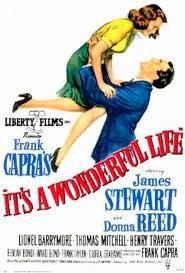Christmas: Movie and music reviews for your holiday
December 17, 2014
It’s a Wonderful Life — 1947

It’s a Wonderful Life — 1947
The glistening of the lights, the snow that falls while family and friends cozy up around the fire and the Christmas tree. Now, if you listen closely you hear the bells, the chiming noise they make letting us know an angel has received its wings. The 1947 classic black and white film, It’s a Wonderful Life is by far one of the best Christmas movies made. This movie teaches the most valuable lesson on giving and the friendships people make throughout their lives.
George Bailey, the main character, is an intelligent but frustrated man who wishes to travel the world and explore beyond it. Unfortunately, he is forced to work at his deceased father’s business, Bailey Building and Loan Association, if he wants to keep it running. He chooses to stay at the business but is very unhappy about these conditions. He then marries the love of his life, Mary Hatcher, and has four darling children.
After saving the business many times, he soon loses $8,000, and has a warrant out for his arrest. He begins to doubt everything and gives up hope on life. He meets a wingless angel, Clarence, who shows him what life would be if George Bailey was never born. All of the great things he has done have vanished and he soon realizes all of the things he’s worried about don’t matter. His family and friends are the people who he loves and wishes to spend a beautiful Christmas with.
When he finally returns home, everyone pitches in money and everything they have to help him. The most important thing about Christmas is giving and the compassion that comes along with it. The lesson Bailey learns is, “No one is a failure who has friends.” At the end of the movie, a bell rings from Bailey’s Christmas tree letting him know Clarence has finally earns his wings. This timeless movie creates a wonderful story for families around the world to watch and enjoy the message that comes along with it.
-Stephanie Iverson, Staff Reporter
Merry Christmas — 1994
Disclaimer: No single Christmas album is the best. There are too many songs catering to different styles, moods, and themes to fit into one; hence, the season’s greatest hits are sprinkled throughout various artists’ tracks. Yet each year, artists vainly attempt reworking classic songs, and releasing Merry Christmas in 1994, Mariah Carey succeeded not by rewriting the classics but creating her own.

Merry Christmas — 1994
The majority of contemporary Christmas albums teeter between having renditions too similar to the originals or completely stripped of festive charm. With her endless octave range and upbeat instrumentals; however, Carey masters creating that modern yet elegant sound. Including hits like “Silent Night” and “Santa Claus is Comin’ to Town,” the 10-song track packs all the greats the holiday’s can’t go without but in consistent soulful style, they feel new and refreshing.
Beyond handling classics with care, Carey broke ground with new titles. Christmas music never was the same after “All I Want for Christmas is You” and “Christmas (Baby Please Come Home)” started blaring on the radio and at parties. R&B vocals and rhythms make these more than just tunes reminding what matters during the holidays to exhilarating pieces you would want to hear any season. Imitation may be the greatest form of flattery, but the reality that few artists even try reproducing these titles demonstrates the untouchable status Carey reigns with them.
From its simple title to iconic cover, Carey’s album is timeless. Singers like Taylor Swift or Ariana Grande may embark on finding the season’s next platinum record, yet Carey already established the 21st century’s holiday sound, and it’s a hard tune to silence. She is today’s Frank Sinatra, Elvis Presley, Bing Crosby; just say Merry Christmas, and it will ring a bell.
-Emily Cieslak, Managing Features Editor


